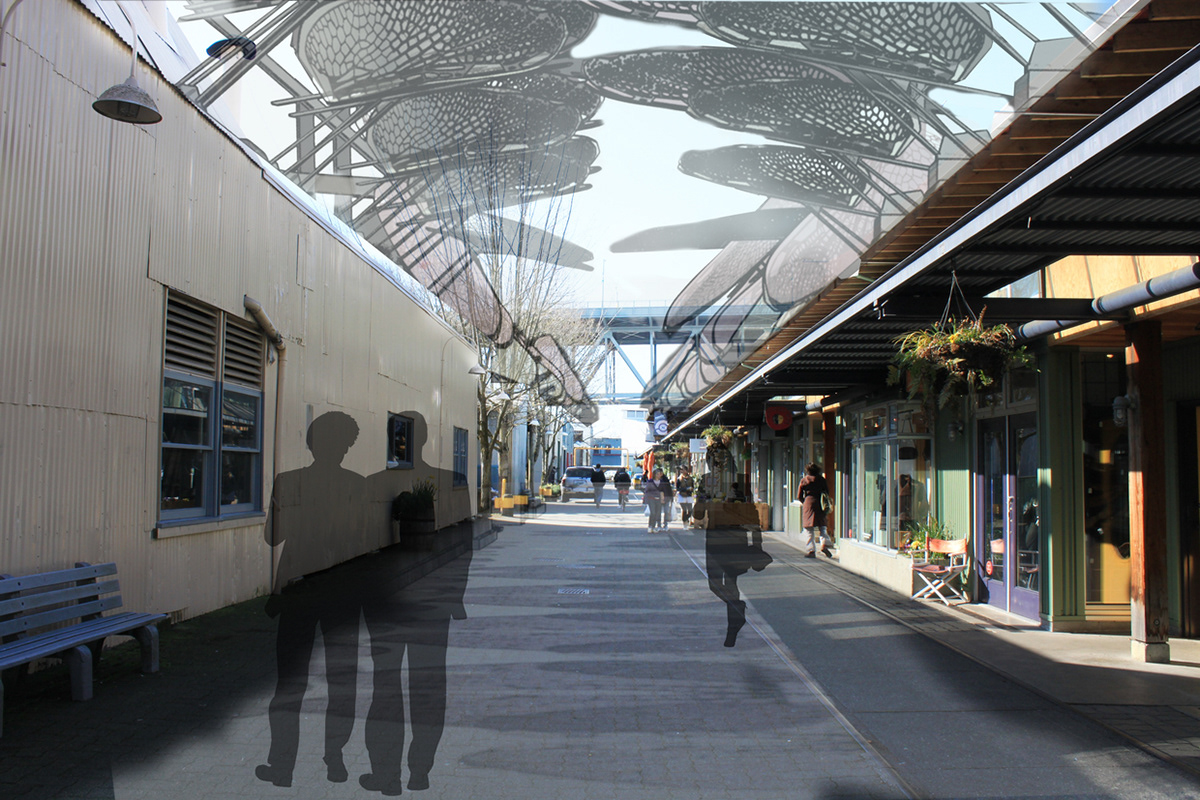Biomimetic Rain Canopy
Kinetic Architectural Interventions
Kinetic Architectural Interventions
"The more our world functions like the natural world, the more likely we are to endure on this home that is ours, but not ours alone." -Janine Benyus
This project was a collaboration between three University of Oregon architecture students, and one industrial design student from Emily Carr University of Art and Design in Vancouver, Canada. We were challenged to create a functioning prototype of a kinetic design solution for Granville Island’s alleys. This design provides a translucent canopy for Railspur Alley, on Granville Island in Vancouver, British Columbia. Its primary purpose is to protect pedestrians from precipitation. A kinetic rain canopy is an appropriate design solution because it can provide rain protection when needed, but can also move in such a way as to admit maximum daylight when the weather is dry.
Credit: Erik Bonnett, Emi Day, Alysha Paiaro
Credit: Erik Bonnett, Emi Day, Alysha Paiaro

Railspur Alley is the only dedicated, pedestrian/ bicycle space on Granville Island. The alley is “a place for strolling, exploration and shopping, ... where one can see artistic and industrial manufacturing first-hand and at a pedestrian scale.”The alley is enclosed by approximately ten 1-2 story industrial buildings, some of which have been adapted to retail uses fronting on the alley.
Contrary to widespread perception, both sun and rain are common in Vancouver, British Columbia. On average, there are 166 days of precipitation annually, which is outnumbered by 289 days with sunshine. Protection from rain could contribute substantially to the success of a pedestrian street, but should not inhibit the enjoyment of sunshine, when present.
We would like to provide a translucent or transparent canopy at Railspur Alley to protect pedestrians from precipitation, while opening in sunny conditions to the weather and sky. A kinetic rain canopy is an appropriate design solution because it can provide rain protection when needed, but can also move in such a way as to admit maximum daylight when the weather is dry.
Contrary to widespread perception, both sun and rain are common in Vancouver, British Columbia. On average, there are 166 days of precipitation annually, which is outnumbered by 289 days with sunshine. Protection from rain could contribute substantially to the success of a pedestrian street, but should not inhibit the enjoyment of sunshine, when present.
We would like to provide a translucent or transparent canopy at Railspur Alley to protect pedestrians from precipitation, while opening in sunny conditions to the weather and sky. A kinetic rain canopy is an appropriate design solution because it can provide rain protection when needed, but can also move in such a way as to admit maximum daylight when the weather is dry.

Various studies of our site, located on Granville Island in Vancouver BC, Canada. Gathering data on dimensions and area that needed to be covered by our rain awning.
As a group, we established the following design criteria:
As a group, we established the following design criteria:

An understanding of movement was crucial, and involved studying how the awning moves, how long it takes for it to open and close, and various other factors.

Inspiration was taken in from various forms found in nature, as we went through various shapes forms and sizes for structure, coverage, and various other factors to be considered. It was our belief that by understanding not only the form of these various naturally occurring shapes, but also how they are structural held together and function in the natural world, we would be able to gain better knowledge of how to design an effective rain awning.





An animation showing the motion of the biomimetic rain canopies as a group of individual events that will celebrate the rain, and create a unique experience beneath the rain canopy.





